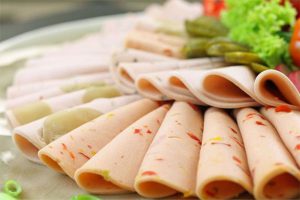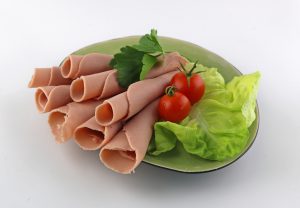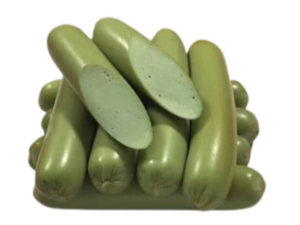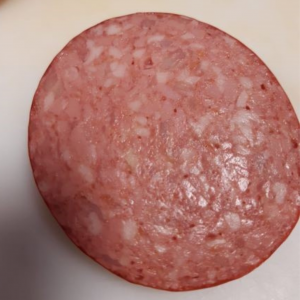Cooked meat is without a doubt more palatable, but the main reason for cooking is to kill bacteria and make meat safe for consumption. The factors that influence cooking are:
- Temperature – the higher the temperature the shorter the cooking time.
- Cooking medium – hot air conducts heat very poorly. Water conducts heat very well. A pizza maker can insert his hand briefly into the hot oven and he will not be hurt. If he inserted his hand to a pot with boiling water his hand will be burned.
- Size and weight of meat. It takes some time for the heat to reach inside of the large meat piece and it will cook slower.
The main losses are:
1. Fat. Once the temperature of the meat reaches about 38° C all fat tissues, regardless from which animal they come, become liquid. Connective tissue that surrounds them softens up but still holds them within. This tissue is composed from collagen and elastin protein, and if the temperature goes over the 38° C mark, the connective tissue breaks down and the liquid fat particles can move around (this does not mean that they will leave the meat). There is very little fat loss between 66 – 88° C or even up to the boiling point of water 100° C. There is a significant fat loss at temperatures over 120° C. This is the range that covers barbecuing, grilling or roasting. At those temperatures the fat leaks out of the meat.
2. Water. Depending on a particular meat cut and the animal it came from, meat can contain up to 20% of protein. Those proteins bind molecules of water, and they are enveloped by connective tissues. Some of them start to cook at 49° C, though most of them start to cook fast between 60° C and 68° C. The effect is squeezing out the water and some loss of water-soluble proteins. The meat shrinks. This loss depends on the meats internal temperature and happens regardless of what cooking media is used.
The fact to remember is that fat melts down at quite low temperatures and although it solidifies again, its looks are already gone. Fry a piece of solid fat on a frying pan and see what happens when it solidifies, it doesn’t look the same. We can’t avoid it altogether (unless we make cold smoked and air-dried products), but there is no reason to intensify the problem by creating unnecessarily high temperatures.
When the source of heat is switched off, the product’s internal temperature will still increase by a few degrees. This is due to the heat transfer from the surface into the inside of the meat. The temperature of the surface of the cooked product is higher than the temperature inside of it.
How and how long to cook meat depends
- the type of meat.
- The cooking methods
Cooking meat
The main reason for cooking meat is to kill the bacteria and make the meat ready for consumption. How and how long to cook meat depends in part on the type of meat.
Cooking Pork
Sausages, hams, and other pieces of meat are considered raw products and must be cooked after smoking. A sausage smoked at 38° C for 6 hrs, will have a great smoky taste, flavour, and colour but it will still be a raw sausage like a fresh sausage that was only ground, mixed with spices, and stuffed into casings. Both must be cooked to safe temperatures before consumption.
For low temperature sausage maker the inside temperature of the meat should fall between 168-72° C. We can stop cooking at a core temperature of 68° C as most products will be of smoked variety and thus previously cured with salt and nitrite which gives us considerably more safety. Meats, which were not previously cured, will not be smoked, just cooked before consumption and the recommended temperature of 76° C. should be observed. The lower the cooking temperature, the juicier and tastier the product is and the weight loss is also smaller.
Cooking Beef and Poultry
There are some sausages made entirely of beef though in most cases beef is mixed with pork. As beef can develop Salmonella.
Cooked poultry rolls and other cooked poultry products should reach an internal temperature of at 71° C prior to being removed from the cooking medium, except that cured and smoked poultry rolls and other cured and smoked poultry should reach an internal temperature of at least 69° C prior to being removed from the cooking medium.
Cooking Fish
Fish is considered done when cooked to 63° C internal temperature. A reliable test is to insert a fork or knife into the thickest part of the fish and twist. The flesh should “flake” (separate).
Cooking Sausages (low temperature sausages)
Sausages, hams, and other pieces of meat are considered a raw product unless heated to an internal temperature of about 68º C, and it is of no importance whether it is done by boiling, steaming, grilling or baking. A sausage might be smoked at 38º C for 6 hrs, will have a great smoky taste, flavour, and colour but it will still be a raw sausage like a fresh sausage that was only ground, mixed with spices and stuffed into casings. Both must be cooked to safe temperature before consumption. Fats start to melt at 35-40° C and going over 76° C internal meat temperature will decrease the quality of the sausage. Staying within 68-72° C will produce the highest quality product.
Special sausages such as blood sausage, liver sausage and head cheese have their ingredients pre-cooked before being minced, mixed, and stuffed. As different cuts like skins, tongues, or jowls for example, will call for different cooking times it may seem that many pots might be needed. The solution is to use one pot but place the meats in separate bags made of netting. Each bag is removed as soon as the meat in it is cooked sufficiently. The leftover stock should be saved and used as a cooking medium as these sausages are cooked in water. If not, enough stock remains, add more water. After sausages are cooked the remaining stock may be used for a soup.
Cooking methods
To achieve the right temperature of the meat, it is also important which method is used to heat the meat. We summarize the most important conclusions
- The thermometer should be inserted in the thickest part of the meat.
- Cured meat will develop the best colour when heated to 72° C. Most sausage recipes contain smoking instructions on required temperatures and times. At higher cooking temperatures sausage shrivelling will be more pronounced.
- In many poorly insulated smokers, the cooking temperature must be almost 4° C higher than the corresponding meat temperature to notice any practical progress (the meat temperature follows the smoker’s temperature but is behind by about 4° C).
- The advantage of cooking in the smokehouse is that smoke may be applied at the same time.
- Cooking losses are smaller when meat is boiled as opposed to baking in the oven.
- The surface area of a cooked product exhibits a higher temperature than the inside and even after the heat source is switched off, the heat will continue to transfer towards the inside. The internal temperature of the meat will still advance by a few degrees.
Meats that were not cured and smoked should be cooked to the following temperatures:
- Fish should reach 63° C as measured with a food thermometer.
- All cuts of pork to 72° C.
- Ground beef, veal, and lamb to 72° C.
- All poultry should reach a safe minimum internal temperature of 74° C.
- Leftovers to 74° C.
It is important that meat reaches the safe internal temperature. There are basically two methods:
- Cooking in a smoker of baking in the oven
- Cooking in water. A large pot plus thermometer is needed. The process can be simplified by using an electric water cooker, soup cooker or turkey fryer as these devices come with an automatic temperature control.
Cooking in a Smoker
It makes a lot of sense to cook smoked meat in the smoker as it is already there. Besides, it will have a slightly better taste than by using the poaching method and it will shine more. On a downside, it will lose more weight than by other methods. It is also the slowest and the most difficult method that largely depends on the technical possibilities of the smoker. A slowly increasing temperature inside the smoker will achieve the best effects. The smoking process is relatively fast, and a typical 36 mm sausage will be smoked in about 1.5-2 hours. Depending on the temperature when the smoking process has ended, such a sausage may be cooked to the safe internal temperature of 68° C in 30 minutes or three hours.
While it takes 1-2 hours to smoke a sausage, it may take an additional 3 hours to cook it inside the smoker. It will largely depend on the inside temperature of the meat when smoking was stopped. If it was 38° C we have a long way to go, if it was 66° C we are almost there. That shows a need for some intelligent planning, and it is advisable to slowly increase the smoking temperature to about 71° C. When smoking is done, the temperature should be increased to 77° C and maintained at that level until the inside temperature of the smoked meat reaches 68° C.
As most products are hot smoked today, the cooking process will be relatively short. It is a good idea to start raising the smoking temperature within the last hour of smoking to finish smoking at a high temperature. Cooking may become part of the smoking process itself and the smoking may end at 68° C making the product both smoked and cooked. A lot will depend on outside conditions and how well the smoker is insulated. That may be difficult to achieve sometimes, and we will have to increase the temperature of a smoker to about 85° C to bring the internal temperature of the meat to the required level.
The other easier method is to set the temperature of the smoker to 77-80° C and wait until the meats inside temperature reaches 68° C. Keep in mind that the smokehouse temperature is around 25 degrees higher than the temperature inside of the meat, but that largely depends on the meat’s diameter. Two thermometers are needed: one to monitor the temperature of the smoker, cooking pot or oven (oven has its own temperature dial), and the other to monitor the inside temperature of the meat or sausage in its thickest part. It helps to have a thermometer with an alarm sounder in it, this way we get an audible warning when the meat has reached its pre-set temperature.
Baking in the Oven
You can bake your meat or sausages in the oven if your unit can maintain temperatures of 88° C or lower (preferably 77° C) and home ovens are normally capable of delivering such low temperatures. If the oven’s lowest temperature will be higher than 88° C switch to the poaching method. Baking sausages in a smokehouse is less efficient that poaching them in water, but they look better having a glossy look on the outside. This is due to the fat that has melted under the surface of the casing and moved to the surface where it resides as a thin coat of grease. It is like putting grease on a pair of boots, they are going to shine and look better. Besides the looks, the flavour of a baked sausage is also slightly better as there was no loss of meat juices which in the case of poached sausages will migrate to the water. The disadvantage is that the baked sausage loses more weight than the same sausage poached in water.
To sum it up: anything falling within 68º – 71º C is cooked to a safe temperature. We can stop cooking at 67º C as most products will be of smoked variety and thus previously cured with salt and nitrite what gives us considerably more safety. Fresh sausages and meats which were not previously cured, will not be smoked, just cooked before consumption and the recommended temperature of 71º C should be observed. The lower the cooking temperature, the juicier and tastier the product is and the weight loss is also smaller.
Cooking in Water
People seldom realize that most sausages, including smoked ones, are cooked in hot water (around 80º C), which on average takes 15-60 minutes, depending on the diameter of the product. It is also easier and faster to apply than cooking in a smoker and the meat weight loss is smaller. This is because water conducts heat more efficiently than air. Water is brought to the temperature of 70-90° C and the meats or sausages are immersed in it.
A rule of thumb calls for about 30 minutes per pound, depending, of course on the cooking temperature. Some recipes call for preheating the water before adding the sausages and some call for adding the sausages to cold water. Most people prefer the latter method. The poaching water should be heated rapidly to 80-85° C. At 80° C the sausages are poached from 10-120 minutes, depending on the type and size of the product. It is generally accepted that 10 minutes are needed for each 1 cm of the width (diameter) of the sausage.
Cooking meats and sausages in hot water is more convenient than baking in hot air. Water in an open container at sea level will always boil at 100° C and no higher. This precisely controls the maximum temperature that can be obtained using the simplest equipment. When baking we depend more on the technical capabilities of the smoker or the oven and more supervision is required.





